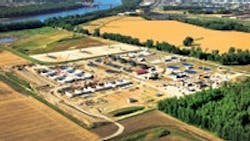Strengthening Connections
About the author: Rick Deremiah, P.E., is technical resources engineering manager for Hanson Pressure Pipe. Deremiah can be reached at [email protected].
For the past two decades, the sprawling campus of the Missouri River Wastewater Treatment Plant in metropolitan St. Louis has undergone a transformation that has seen significant upgrades, capacity improvements and new treatment capabilities—all without requiring taking the plant offline for significant periods of time.
In the first phase, completed in 2009, the municipality rebuilt the headworks facility. In the $90 million second phase, which is in progress, the team will boost capacity from 28 million gal per day (mgd) to 38 mgd, while upgrading treatment capabilities to meet new and changing U.S. Environmental Protection Agency regulations.
The second phase includes removing the existing secondary treatment process and four trickling filters and replacing them with an activated sludge process, followed by an ultraviolet disinfection facility. Infrastructure includes a new low-lift pump station, six aeration basins, a blower building, six 125-ft-diameter final clarifiers, a sludge pumping station, a solids-handling building, a primary digester and two splitter structures. The team is changing the facility’s solids treatment process, switching from gravity belt thickeners to rotary drum thickeners and centrifuges, which will allow for higher treatment volumes.
For pipeline connections between each building, prestressed concrete pressure pipe (CPP) was selected for its durability and reliability. The Hanson concrete pressure pipe selected includes 3,324 ft of E-301 (prestressed concrete-embedded cylinder pipe) in 54- to 108-in. diameters and 3,926 ft of L-301 (prestressed concrete-lined cylinder pipe) in 30- to 42-in. diameters.
Because the existing facility had ample room to grow, engineers were able to implement each phase of the project without taking the plant offline. Still, care was required for work near existing structures. For example, installation of new 66- and 72-in. line next to the existing trickling filters required Goodwin Brothers to install an elaborate sheet pile system, ensuring that the filter remained in service and did not settle.
Instead of using traditional lifting slings, Goodwin Brothers and Corrigan used a Kenco self-leveling pipe hook to handle pipes, a move they said resulted in notable time savings on site.
Applying Concrete Pressure Pipe
CPP is used in 90 of North America’s 100 largest metropolitan areas. By combining the structural properties of steel and concrete, CPP is highly corrosion resistant, strong and does not require special bedding and backfill procedures.
The Missouri wastewater project used both E-301 and L-301. The pipe features a concrete-lined steel cylinder (L-301) or a steel cylinder embedded in a concrete core (E-301), helically wrapped with high-tensile-strength steel wire, then coated with a layer of Portland cement mortar to electrochemically protect the pipe against corrosion. L-301 is manufactured in diameters from 16 to 48 in. and laying lengths from 16 to 32 ft. E-301 comes in 54- to 144-in. diameters and laying lengths from 12 to 24 ft.
Prestressed concrete cylinder pipe (PCCP) is an ideal choice for water and wastewater treatment plants’ large and complex pipe systems because it combines the tensile strength of steel with the compressive strength and corrosion-inhibiting properties of concrete and mortar. The prestressing wire wrap places the steel cylinder and concrete core in a state of circumferential compression, allowing the pipe to withstand internal hydrostatic pressure and external loads. The rigid strength of PCCP eliminates the reliance on backfill for lateral support, reducing the cost and installation time.
CPP is particularly suited to safely carrying aggressive flow to water and wastewater treatment plants, including natural waters, highly septic sanitary sewage and a wide range of chemicals and industrial waste materials. It may be necessary to line the interior of the pipe to handle some flows; an engineer can help evaluate any potential threats and recommend the appropriate protective measures.
Although the humid environments in interior piping galleries can induce atmospheric corrosion of ferrous pipe materials, CPP actually thrives under the same conditions. In fact, the cement-rich mortar that coats the concrete pipe and fittings gradually gains additional strength in such humid environments.
The ability of the pipe’s cement-rich mortar coating to inhibit corrosion is another important benefit of using CPP in water and wastewater treatment plants. The alkaline environment created by the mortar yields a pH value of about 12.5 around the steel, placing the pipe’s steel components into a passive state that is safe from corrosion.
For greater design flexibility and easier installation in complex and crowded water and wastewater treatment plants, PCCP can be supplied in short sections, bevel and half-bevel deflections, and special sections fitted with various types of tangent and centerline outlets.
Hanson Pressure Pipe also provides a range of fittings—including wyes, elbows, tees, manifolds, headers and reducers—to match its CPP lengths. All fittings are fabricated to meet the same pressure and loading conditions as the adjacent pipe. The matching fittings are made from welded steel sheet or plate, with the appropriate type of steel joint rings welded to each end and then lined and externally coated with cement mortar or concrete for lasting protection. Water pressure inside each fitting is fully resisted by the steel cylinder, and outlets in the pipe and fittings are reinforced by replacing the area of steel removed from the wall with either wrappers, saddles, collars or crotch plates.
To reduce costs, installation time and space requirements, many of the fittings for complex layouts can be custom designed and made by combining such features as special ends, outlets, reducers, and wall flanges all into the same fitting.
Download: Here
